The Lost City of Aztlan, the so-called birthplace of the Aztec civilization, presents a fascinating mystery for historians and archaeologists alike. This legendary abode is said to be the ancestral home of the Aztec people, from where they embarked on an epic migration to the Valley of Mexico.

Despite its mythical status and significant cultural importance, its precise location and existence remain shrouded in uncertainty. This article delves deep into the tales, theories, and ongoing debates about the Lost City of Aztlan.
Aztlan: The ancestral home of the Aztec people
The term Aztlan, as per Nahuatl language, denotes “the land to the north; the land from whence we, the Aztecs, came.” It’s believed to be an island situated on a lake, a paradise, and a place of origin for the Aztecs, known as the Mexica people. The tales of Aztlan depict a place of abundance, a haven for its inhabitants. However, some accounts also portray it as a realm under the rule of the tyrannical Azteca Chicomoztoca elite.
The legend of the seven tribes
The mythology of Aztlan centers around the saga of seven Nahuatl-speaking tribes. These tribes, namely Acolhua, Chalca, Mexica, Tepaneca, Tlahuica, Tlaxcalan, and Xochimilca, were believed to have resided at Chicomoztoc, translated as “the place of the seven caves.” These tribes united near Aztlan, forming the Aztec civilization. Interestingly, the arrival of these seven tribes was allegedly preceded by the Chichimecas, a group deemed less cultured.
The migration from Aztlan

The migration from Aztlan to Tenochtitlan, the heart of Mexico City, is a pivotal event in Aztec history. According to legend, the Aztec people were led out of Aztlan by their priest to escape the oppressive rule of the Chicomoztoca. This journey commenced on May 24, 1064, marking the first Aztec solar year.
Aztlan’s possible location
The exact geographical location of Aztlan continues to be a topic of intense debate. The quest for Aztlan extends from Western Mexico to the deserts of Utah, indicating that the Aztecs might have originated in an area now part of either Northwestern Mexico or the Southwestern United States before their migration to the Valley of Mexico. However, no definitive evidence has been found to pinpoint Aztlan’s location.
Theories about Aztlan’s existence and the search for the lost ancient city
While some consider Aztlan as a mythical land, much like Atlantis or Camelot, others argue for its physical existence. Some even postulate that Aztlan and Atlantis are, in fact, the same place, known by different names. However, this hypothesis has faced several rebuttals. Despite the conflicting views, the quest for the Lost City of Aztlan remains undeterred.
The search for Aztlan has been complicated by several methodological issues. These include “stretching,” which refers to the likely zig-zag pattern of Aztec migration; “layering,” which acknowledges the possibility of multiple north-to-south migrations; and “folding,” which suggests the potential for back-and-forth migrations. These factors add to the difficulty in establishing Aztlan’s real existence and location.
The cultural and historical significance of Aztlan
Despite the ambiguity surrounding its existence and location, Aztlan holds immense cultural significance for the Aztec people. It symbolizes their origin and historical journey, shaping their cultural and societal norms. In this context, finding Aztlan would provide a deeper understanding of ancient Mexican history and the roots of the Aztec civilization.
Currently, the consensus among archaeologists is that even if Aztlan were discovered, it is unlikely to yield significant archaeological finds. However, the discovery would offer valuable insights into the origin of the Aztec civilization. As such, the focus remains more on the Aztecs’ migration to the Valley of Mexico and the subsequent events rather than their place of origin.
Aztlan’s impact on modern discourse
The debate about Aztlan’s location has also found its way into modern political discourse. Some argue that if Aztlan were located within the current United States boundaries, the descendants of the Aztecs could claim they are not undocumented immigrants but merely returning to their ancestral homeland. This perspective adds another layer of complexity to the mystery of the Lost City of Aztlan.
Conclusion: The unending enigma of the Lost City of Aztlan
The Lost City of Aztlan remains one of history’s enduring enigmas. Its existence and location continue to be subjects of captivating debate, with myriad theories but no definitive answers. Whether Aztlan will ever be found or will remain a legendary place in Aztec history is a question yet to be answered. Nonetheless, the quest for this mythical city underscores the enduring allure of ancient civilizations and our unending quest to unravel their mysteries.



